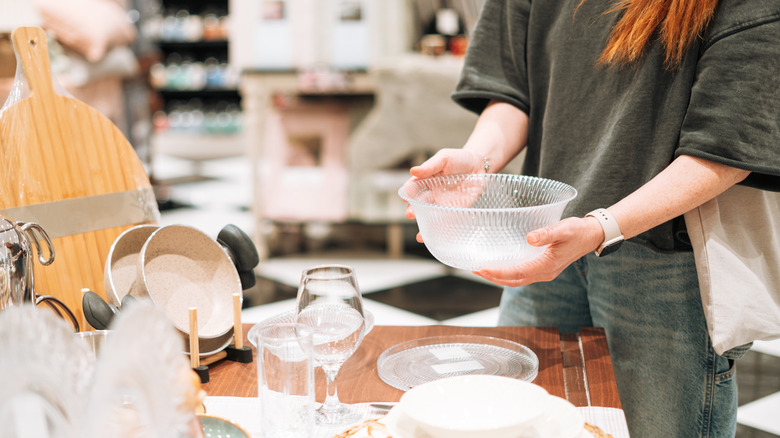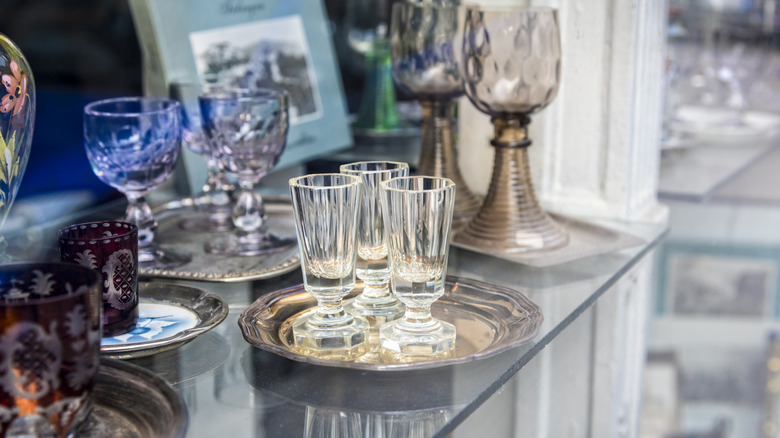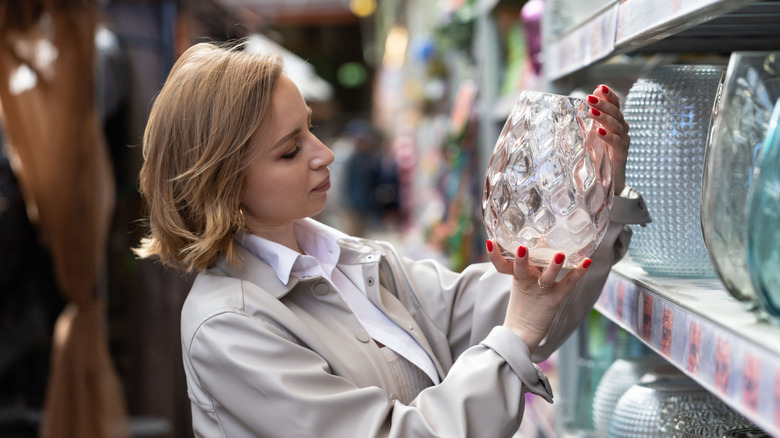How To Tell Valuable Crystal From Cut Glass At The Thrift Store
Thrifters know that bargains abound at resale shops, tag sales, and antique dealers. Usually what you see is what you get, but every now and then, a truly valuable piece is tucked behind something innocuous — or sitting right in front — on a shelf in a thrift store. That glass decanter might be worth much more than the price tag. How would we recognize the items that are special? How could we determine if a vase was handcrafted a century ago or mass-produced in the 1990s? We reached out to an expert for help with a common sight in places like thrift stores: pretty items made of glass. Is it cut glass or is it crystal? Dr. Lori Verderame, Ph.D., of www.DrLoriV.com, is an antiques appraiser and television personality who spoke exclusively to House Digest about how to tell valuable crystal from cut glass at the thrift store or wherever you may encounter it for resale.
Always in demand on television and as an antiques expert, Dr. Lori's passion really began in childhood, as she and her father explored antique shops and sales. With all her expertise she knows key details about thrifted glass, like how to spot authentic depression glass when shopping at estate sales and, of course, how to identify real crystal. Don't be fooled into thinking that clinking two wine glasses together and listening for bell-like tones is enough, she warns. Everyone hears things differently. Dr. Lori provided crystal recognition tips to House Digest that include visual clues like clarity. "Crystal is clearer to see through than a similar piece of glass," she said. However, she told us there is much more to this crystal iceberg.
A leading expert offers crystal ID clues
You pick up a glass bowl in a thrift shop and are stunned at how heavy it is. If you're hoping to find lead crystal, celebrate a win, according to Dr. Lori Verderame, Ph.D. Speaking exclusively to House Digest, the antiques appraiser and TV personality said that "crystal has weight" and should feel "heavier than a piece of glass of the same size." The reason for that is simple. Lead crystal is glass that includes lead oxide. Lead is dense and therefore heavy; it also gives the glass its signature light refraction.
"A piece is deemed crystal if it has 24% lead content or higher. If it doesn't have the 24% lead content, it is not crystal. There is no faux crystal," Dr. Lori said. How else can you tell the difference between crystal and cut glass when browsing the thrift store glass section? One way to tell valuable crystal from cut glass is the clarity. Is it clear? Does it sparkle in the light? Unfortunately, if the piece is dirty and dingy, and you are in the shop, you can't exactly clean it to examine it. You could take a chance on it then go with the simplest and most effective way to clean thrifted vintage crystal.
Even experienced thrifters benefit from authentication tips
If you're out at a thrift store and you have some experience, your eagle eye probably can spot the good stuff. You know the most valuable things to look out for at estate sales, and crystal may be one of the items you seek out. It still can be challenging to authenticate if a piece is crystal, though, so we turned to an antiques appraiser. Dr. Lori Verderame, Ph.D. spoke exclusively to House Digest about figuring out items that might be lead crystal versus cut glass in a thrift shop. In addition to providing us with tips on recognizing crystal, she added her insights on types of items to look for and which manufacturers are in demand.
For people who enjoy it, browsing row upon row in a thrift store is like a treasure hunt (without the risk of a pirate attack), and as we listened to Dr. Lori, it was clear that she shares that excitement for the hunt and the discovery that awaits. We asked her if there were specific pieces that our readers should look for. "Crystal bowls, candy dishes, wine glasses, goblets, and sculptures in crystal are highly collectible and valuable," she explained. Dr. Lori also said that it's helpful to know the top manufacturers of crystal before heading out to estate sales or resale shops. "Manufacturers of crystal that readers should look for include Waterford, Swarovski, Steuben, Baccarat, Lalique among others," she said. The most recognizable of these iconic companies are from Europe and the United States. Baccarat, Waterford, Swarovski, and Lalique are based in Europe, while Steuben is based in the U.S.


